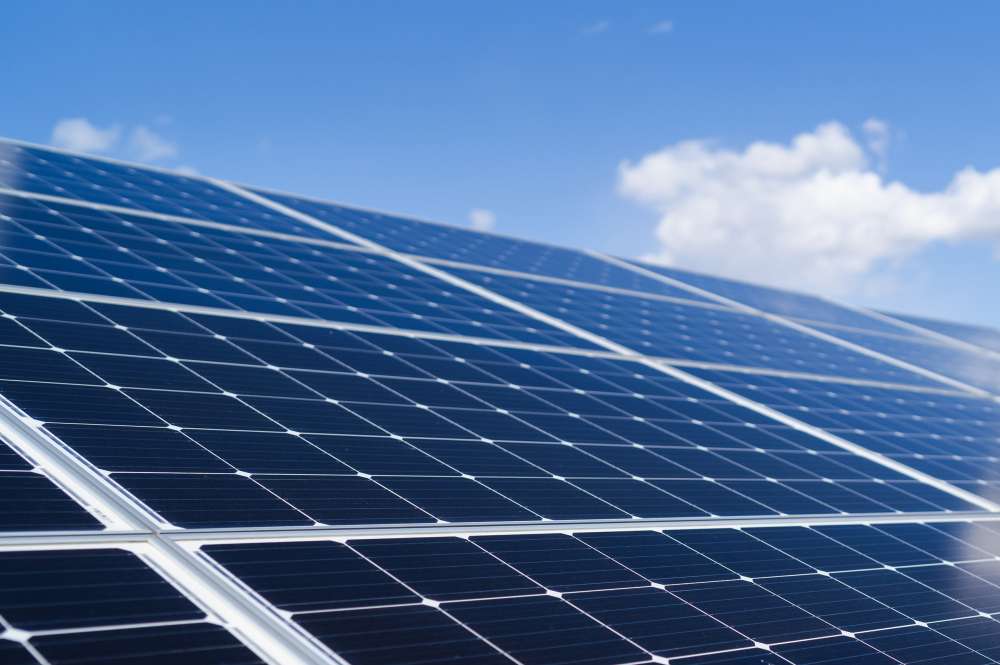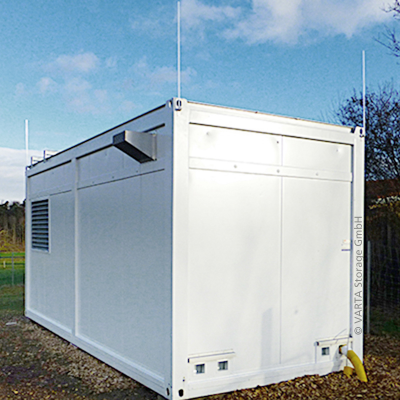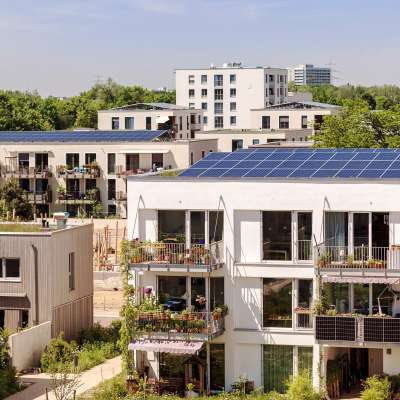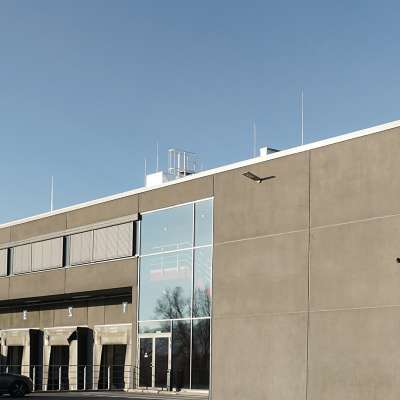Lightning and surge protection for photovoltaic systems
How to ensure profitability and independence
Whether on residential buildings for more independence from the electricity supplier, on the roofs of industrial buildings to reduce energy costs or as large-scale solar parks to supply entire regions with clean electricity: photovoltaics is a core element of renewable power generation. Yet they are also susceptible to overvoltages that can be caused by thunderstorms and lightning or by unexpected fluctuations in the power grid. Protective measures are a must in order to fulfil normative requirements, prevent failures, secure investments and avoid reinvestment costs.
Protect your photovoltaic systems with our lightning and surge protection concepts. Find out more about our solutions for protecting photovoltaic systems.

Reliable protection for renewable energy generation
A failure of the PV system has expensive consequences: there is no electricity generation for personal use or income from energy infeed, and additional costs are incurred for repairs. We offer comprehensive protection concepts for surge protection, earthing and equipotential bonding, as well as for the external lightning protection of photovoltaic systems.
Photovoltaics for the building
The photovoltaic system is the core element in professional energy management. Protect components from avoidable damage and costly failures.
Ground-mounted PV systems
A lightning protection system for ground-mounted PV systems protects them from direct lightning strikes and transient overvoltages. It protects the power plant area as well as the modules, the inverters and the plant monitoring system.
Standard-compliant protection for PV systems
Protection against lightning and surges plays a central role in the planning and installation of photovoltaic systems. The following normative specifications must also be complied with in order to operate the system safely and efficiently.
- IEC 60364-7-712
- IEC 62305-3
- IEC 60364-4-44
DEHN Services
We can provide support for your project from the planning to the implementation and beyond. Take advantage of our wide range of practical tools and services.
DEHN Engineering Services
We create the entire lightning protection concept – from the risk analysis and earthing simulation to budget planning – all precisely tailored to your project, and standards-compliant.
DEHN Test Centre
Independent, powerful testing for products, installations and systems, accredited according to DIN EN ISO / IEC 17025. The tests and their results are documented in internationally recognised test reports.
FAQs
Does the installation of PV systems on or near buildings increase the risk of lightning strikes?
No, the risk of a lightning strike is not increased by the installation of a standard PV system on or near a building.
How does surge protection for photovoltaic systems work?
Surge protection for photovoltaic systems is crucial to protect the system from damage caused by unexpected voltage peaks. These can be caused by external events such as direct lightning strikes, indirect lightning strikes in the vicinity or switching operations.
Here is a simplified explanation of how it works:
- Detection of surges: surge protective devices (SPDs) are designed to continuously monitor the voltage and react to unusual peaks.
- Dissipation of the overvoltage: in the event of a surge, the SPDs safely discharge the excess energy to the ground before it can reach the sensitive parts of the photovoltaic system.
- Protection of system components: by discharging the overvoltage, the SPDs protect the solar modules, the inverter and other electronic devices.
There are two main types of surge protection:
- AC-SPD: protects the AC side of the system.
- DC-SPD: protects the direct current side, in particular the solar modules and the inverter.
What happens to the photovoltaic system without surge protection?
Without surge protection, the consequences for a photovoltaic system in the event of a lightning strike can be serious. Here are some possible scenarios:
- Total loss: a direct lightning strike to the system can lead to a total loss, whereby the solar modules, the inverter and other electronic components can be irreparably damaged.
- Indirect damage: indirect lightning strikes that hit other parts of the building or cables can also cause overvoltages that lead to damage to the photovoltaic system.
- Failure of technical equipment: surges can cause technical devices to fail, which can lead to costly repair work.
- Fire hazard: there is also a risk of fires being caused by the overvoltage. This not only jeopardises the system, but also the building.
It is therefore important to install suitable surge protection to minimise these risks and ensure the safety and longevity of the photovoltaic system.
What types of surge arresters are there?
Surge arresters are divided into three classes: Type 1, 2 or 3. The arresters differ in their discharge capacity and protection level. The protection level indicates the maximum voltage that occurs in the event of a discharge process.
Class 1 = primary protection
The arresters have the highest impulse current capability and are designed for the load of a direct lightning strike. If the protection level of the Type 1 arrester is higher than the dielectric strength of the downstream devices to be protected, a Type 2 arrester must be connected downstream.
Class 2 = Medium-level protection
The arresters are designed for surge currents that are to be expected in the event of indirect lightning strikes.
Class 3 = Secondary protection
These arresters have the lowest impulse-current-carrying capacity and protect sensitive devices such as PCs, TVs, etc.
What type of surge arresters do I need to use to protect the PV system?
This depends on whether an external lightning protection system is present and, if so, whether or not the separation distance between the lightning protection system and the PV components has been maintained. In this regard, see the protection proposals in WPX029.
What other differences are there between surge arresters?
In addition to the arrester types, DEHN also differentiates between Red/Line and Yellow/Line arresters.
- Red/Line arresters describe all types for the energy part of a photovoltaic system.
- Yellow/Line arresters are intended for use in the area of signalling and communication lines.
Does an arrester have to be replaced after every discharge process?
No. Surge arresters from DEHN can discharge lightning currents several times. This has been proven by various laboratory tests and also confirmed by our many years of experience in the field.
However, you should regularly check whether the arresters are still functional. You can determine whether the device is functioning or defective by the green-red marking in the inspection window.
Where is the surge protection for PV systems with external lightning protection installed if the separation distance is maintained?
- DC voltage cable: If the DC cable is longer than 10 metres, a Type 2 surge protective device should be installed at the connection to the photovoltaic modules.
- Inverter: Installation of Type 2 surge protective devices upstream and downstream of the inverter.
- Electrical installation of the building: To protect the electrical devices in the building, a Type 1 surge arrester should be installed in the power grid feed.
Where is the surge protection for PV systems with external lightning protection installed if the separation distance is not maintained?
- Inverter: Installation of Type 1 surge protective devices upstream and downstream of the inverter.
- Electrical installation of the building: To protect the electrical devices in the building, a Type 1 surge arrester should be installed in the power grid feed.
Do the modules of a PV system have to be earthed?
For lightning protection reasons, it is not necessary to integrate the module frames into the earthing system. Only the mounting system needs to be integrated for this. That being said, certain module types require earthing; please refer to the module manufacturer's instructions in this regard.
What needs earthing in a photovoltaic system?
When earthing photovoltaic systems, certain components must be earthed to prevent personal injury and damage to the system. Here are the essential elements that need to be earthed:
- Frame of the solar modules: For lightning protection reasons, it is not necessary to integrate the module frames into the earthing system. Only the mounting system needs to be integrated for this. That being said, certain module types require earthing; please refer to the module manufacturer's instructions in this regard.
- Mounting system: The frame on which the solar modules are mounted, especially if it is made of steel or aluminium, must also be earthed.
- Metal cable trays and cable conduits: All metal parts that are connected to the cabling of the system should be included in the equipotential bonding.
- Inverter housing: If the housing of the inverter is made of metal, it must also be earthed.
Earthing is required by law and must be carried out in accordance with standards such as IEC 60364-5-54 and IEC 62305-3.
What happens if a photovoltaic system is not earthed?
Earthing is used to safely discharge excess electrical charges. If a photovoltaic system is not properly earthed, this can lead to several serious problems:
- Electric shocks: there is an increased risk of electric shock.
- Fire hazard: inadequate earthing can lead to a fire.
- System damage: the efficiency and performance of the photovoltaic system can be impaired, as earthing also helps to protect the system from overvoltages.
- Electromagnetic interference: without earthing, electromagnetic interference can disrupt the function of the system and reduce energy production.
Earthing is therefore a critical safety aspect that should not be neglected.
Why is equipotential bonding important for photovoltaic systems?
Equipotential bonding is an important safety measure for photovoltaic systems that serves to compensate for voltage differences between different conductive parts of the system.
- Prevention of electric shocks: equipotential bonding balances dangerous voltages between the parts of the system, which reduces the risk of electric shocks.
- Protection against surges: equipotential bonding helps to protect the system from electrical surges that can be caused by indirect lightning strikes or switching operations in the grid.
- Minimisation of fires and short circuits: correct equipotential bonding minimises the risk of fires and short circuits that can be caused by unequal voltages.
- Reduction of electromagnetic interference: electromagnetic interference can impair the performance of the system. Equipotential bonding helps to minimise this interference.
How is the inverter of a photovoltaic system earthed?
Earthing the inverter of a photovoltaic system is an important step in ensuring the safety of both the system and people. The following steps are required for earthing an inverter:
- Selecting the right earthing system: An earthing system must be selected that complies with standards such as IEC 60364-5-54 and IEC 62305-3.
- Connection with the main earthing busbar: The inverter should be connected to the main earthing busbar, which in turn is connected to the main earthing conductor (foundation earth electrode).
- Connection of the protective conductor: A protective conductor must be routed from the inverter to the main earthing busbar in order to safely discharge potential residual currents or overvoltages to earth.
- Testing the system: After installing the earthing system, the system should be tested to ensure that the earthing has been implemented correctly and in accordance with standards.
Which cable is used for earthing a photovoltaic system?
Cables that comply with the standards and requirements for electrical installations are generally used for earthing a photovoltaic system.
Cable type: It is recommended to use cables according to IEC 62930, which are specified for the cabling of photovoltaic systems.
Conductor cross-section: The conductor cross-section of the earthing cable should be sufficiently dimensioned to safely conduct the expected current. A 1 x 16 mm² green-yellow wiring cable is often used for earthing the mounting system of the photovoltaic system. There are differences here with regard to the differentiation criteria:
- Buildings with PV systems, without external lightning protection
- Buildings with PV systems, with external lightning protection and sufficient separation distance
- Buildings with PV systems, with external lightning protection, without sufficient separation distance
It is important that the cables are selected and installed in accordance with the applicable regulations and standards such as IEC 60364-5-54 and IEC 62305-3.
How deep must the earthing of the PV system be?
The depth of the earthing for a photovoltaic system depends on the local conditions and must ensure that it is frost-free. An installation depth of at least 0.5 m is required. This depth ensures that the earthing system is protected from frost and can fulfil its function reliably. The installation depth should be selected so that the effects of frost, soil dryness and corrosion are minimised. Earth electrode lengths of 9 m have proven to be advantageous.
What cross-section is required for earthing a PV system?
A cable cross-section that meets the safety requirements and standards is required for earthing a photovoltaic system. According to IEC 60364-5-54, the cross-section for earthing should be at least 6 mm² of copper. If the earthing also fulfils an overcurrent function, such as for lightning protection, a cable cross-section of at least 16 mm² is required.
How is the external lightning protection installed to protect a PV system if the separation distance is maintained?
- Photovoltaic modules, mounting system, cabling: Air-termination systems are installed in such a way that these system components are located in the protected volume and a direct lightning strike to the system components is prevented. The cables of the lightning protection system must be laid at a distance from all parts of the photovoltaic system that prevents flashover (separation distance). This must be calculated precisely by a lightning protection specialist, for example.
- Mounting system: The metal mounting system is connected to the main earthing busbar. In the case of extensive systems, the connection can also end at an equipotential bonding bar. [Textumbruch]Important: A direct connection between the mounting system and the lightning protection system cables must be avoided at all costs.
How is the external lightning protection installed to protect a PV system if the separation distance is not maintained?
- Photovoltaic modules, mounting system, cabling: Air-termination systems are installed in such a way that these system components are located in the protected volume and a direct lightning strike to the system components is prevented. The air-termination systems are connected to the modules or the mounting system several times. These connections must be designed for partial lightning currents.
- Module frame, mounting system: The metal parts must be suitable for the conducting of partial lightning currents in terms of material and connection technology.
What other topics are of interest to you?
Just select them and read on.

Battery storage system
Battery storage systems play an important role in energy management. A customised lighting protection and surge protection concept reliably protects storage systems.

Residential building
More and more households are supplying themselves with solar power. A harmonised protection concept protects people and systems and ensures an uninterrupted power supply.

Commercial and industrial construction
An integrated lighting protection system reliably protects the PV system from overvoltage, increases availability and secures yields.
Do you have questions about the protection of photovoltaic systems?
We are happy to answer any questions you may have on the topic of photovoltaic systems.
You can reach your contact person at itss@dehn.de.